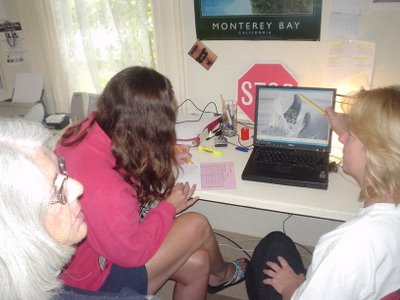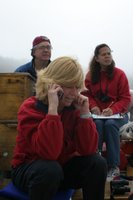Earthwatch Expedition: Marine Mammals of Monterey California Team 3 Aug 30-Sept 8 2006
The mission of this expedition is to get to know the sea otters and bottlenose dolphins of central California's coast. As a middle school science teacher, I will join scientists in the field to participate in a population study of marine mammals. This expedition experience is funded by the Earthwatch Institute through grants from Wells Fargo Bank and the National Geographic Education Foundation. I will keep in contact with my students in Phx, AZ to share the experience.
About Me
- Name: Donna Konkright
- Location: Phoenix, Arizona
I love taking my family on trips that are educational, adventurous, but most of all fun! Last year the four of us went to Karchner Caverns and had a great time. In years past Michelle and I have gone on scuba trips including a great trip to Keylargo Florida where we went diving each day in the warm waters. This year is so exciting as we anticipate our adventure to Baja Mexico to pet the Grey Whales that migrate there for just a short time to give birth to their young.
Friday, September 08, 2006
Thursday, September 07, 2006

THURSDAY, SEPTEMBER 7
Today was the last day in the field for team 3. We boarded the Astirix for the final dolphin study. Once again, the goal was to spot bottlenose dolphins and take pictures for photo ID. The team got lucky and found about 20 dolphins to photograph. My job was to spot dolphins and alert the captian and the scientists taking the photos. Peter Nilsson a marine biologist was taking the photos.
Daniel S.
Q: Did the elephant seal get bit by a shark?
A: We checked on the injured elephant seal everyday after we found her hauled out. The rescue specialists are not sure how her injury occured. She has since returned to the water and has a good chance of recovery.
Jose S.
Q: How can you tell if a sea lion is a boy or girl.
A: It is difficult when they are in the water unless they are swimming with a pup because the part of the anatomy that you need to see is underwater. Here is a website that gives information on that.
http://nmml.afsc.noaa.gov/education/pinnipeds/California.htm
Lydia C.
Q: Are sea otters cute?
A. I sure think so, but check out these pictures and decide for yourself.
http://images.google.com/images?q=pictures+of+sea+otters&hl=en&lr=&sa=X&oi=images&ct=title
Siera H.
Q: What do sea otters eat?
A: Sea otters in Central California have a diet of mostly clams, crabs, and marine worms. We got close enough to them yesterday to hear them crunching on Green crabs and breaking clam shells with a rock on their chest. Open this website to see otters eating.
http://images.google.com/images?svnum=10&hl=en&lr=&q=pictures+of+sea+otters+eating&btnG=Search
Wednesday, September 06, 2006



Sea Otter Census
I enjoyed talking live from the field to my classes today via conference calls. The day began with meeting Tom Kieckhefer at Moss Landing Harbor. Tom is Associated with Friends of the Sea Otter, and thePacific
cetacean Group. Before we boarded the vessel for the census, Tom educated us on general information on sea otters. He brought hands-on materials including an otter skull, an otter pelt, and various clam shells that helped us be able to identify the types of clams that sea otters prey on in this area. Once again, the census was conducted by slowly traveling the seven mile Elkhorn Slough and collecting data on each otter sighting. My task was to spot the otters and time their dives when they were foraging for food. The average dive time was 60 sec. We observed otters surfacing with Green Crabs, Washington Clams, and Gaper Clams. We were close enough to hear them crunching the crabs and breaking open the clams by using a rock on their chest. The final count of today's census was 82.
Tuesday, September 05, 2006



Biopsy Samples
A significant part of Dr. Jefferson's study on bottlenose dolphins involves obtaining and analyzing biopsy samples. Although the cross bow looks menacing, his previous work in Hong Kong has proven it to not cause any sinificant harm to the animal. A great deal of information can be learned from either the skin or blubber of the animal. The blubber can reveal pregnancy, stress, prey identity (fatty acids of species) and contaminants. The skin is used for DNA tests. The DNA can be evaluated to show taxonomy or relationships of the individual to others. Hitting the animal with the dart is very challenging! Each shot is recorded (hit/miss), reaction of the animal (tail swish, fluke slap, breach), GPS, species and beaufort (condition of the water surface). Two biopsy samples were collected in the field today.



Here are a few more photos from today. We saw a few mothers with their pup.
Questions:
1. How can you tell a juvinile dolphin from an adult, other than the size?
2. How often does a dolphin need to surface in order to breath?
3. What are the most common prey of a dolphin?
4. What are preditors of the bottlenose dolphin?


September 8, 2006
At 9:00am we boarded the Astirix. The task for the day is to study bottlenose dolphins in Monterey Bay. A survey log will be used to record sightings of dolphins and all other marine mammals we encounter. When taking photos of the dolphins, the scientists attempt to get a perpendicular shot of the dorsal fin in order to see the indentifying notch marks that are the most useful when doing photo ID. Today was the best day yet for dolphin sightings. Over 400 photos were taken during the day. Tonight, back at the house we will preview each photo and rate them for quality, try to match them to previously identified dolphins, and make sketches of fins that may belong to new dolphins.


September 3, 2006
Today was spent conducting 5 minute otter surveys of the "raft" in Moss Landing Harbor. At this time a large percentage of the otters live in this area. That has not always been the case. When doing the five minute surveys, you record the behavior of each otter in the raft scanning from left to right. One of the goals of this type of survey is to see if sea otter behavior is different when they are gathered in a raft as opposed to being separated from the raft. The photo on the right is of a elderly sea otter. Approximate age of sea otters is determined by the amount of grizzling (grey fur) on the face.
Monday, September 04, 2006
Sunday, September 03, 2006
Saturday, September 02, 2006

 Sea Otter Census
Sea Otter CensusThe task for my group today was to take an entire census of the population of sea otters in the Elkhorn Slough and Moss Landing Harbor. The method for the census was to travel down the 7 miles of the Slough and then turn around and begin the census count. On the slow trip back data was collected for each sea otter siting. The data consisted of the number of otters in the sighting, sex and approximate age, the location in the Slough, latitude and logitude of the sighting (using GPS), distance from the boat, and a bearing determined with a compass. There was a team of three collecting the data. Each member was assigned a particular task. I was sitting on the bow of the boat taking down the data and checking the GPS for latitude and longitude while others called out the other pieces of data that needed to be recorded. It was not too difficult when only a few sea otters were spotted in an area. The challenge began when we returned to the harbor and there were 35 sea otters gathered in a "raft" and all the information had to be gathered on all of the otters in the short time that the boat was passing by the large group. It was difficult to listen and record all the data quickly. It takes a lot of team work to accomplish this type field work.
Questions:
1. What does the term census mean?
2. What is meant by the term "raft" in this post?
3. The term "GPS" has been used in 2 posts. What does it stand for and how does it work.
4. How do you determine the approximate age of a sea otter?
Good Luck and have fun finding the answers to these questions!

Dolphin Identification
The day started with a quick breakfast and then myself and 2 other members of the team stayed back at the house and were taught how to use photographs to identify dolphins. The main identifying feature of a dolphin is the shape and notches in the dorsal fin. We looked at hundreds of photos and classified them as excellent, good, fair, poor, or bad. We also made sketches of the fins and tried to find photos that matched. This was an enjoyable task and after a while you could start to identify the dolphins. It was so cool when you would bring up a photo and immediately be able to say "that's dolphin B" After a lot of supporting data that identifies a particular dolphin, the dolphin is given a name. Some of the names that have been given are Wild Woman, Hook, Two Tricks, Lizard, and Daisy. If a new dolphin is identified during this expedition, we will get to help name it!
Friday, September 01, 2006



September 1, 2006
Today we headed out at 8:30am on the Astirix, the boat designated for dophin studies. Our captian, Sean Von Sommeran has over 30 years experience at sea and has been conducting research projects for the past 15 years in Monterey Bay and the Eastern Pacific. The other scientist aboard was Thomas Jefferson, ph.D. He has been studying marine mammals since 1983, and has conducted research on a variety of different species in the United States, Canada, Mexico, Peru, Africa, and Southeast Asia. We were in good company!
The survey log that we utilized for data collection was filled out each time any marine mammal was spotted. We documented time, longitude and latitude (using a hand-held GPS unit), beaufort (sea conditions), cloud cover, wind direction, species code, and species count. This became very labor intensive when multiple sightings took place in short periods of time. Marine mammals sightings today included harbor poroises, sea otters, California sea lions, an elephant seal and a humpback whale. Basically, we had sightings for every marine mammal that resides in the area except for the bottlenose dophins that we were looking for. That's field science for you.
The Humpback whale siting was of course the hit of the day. We kept track of the whale's position for about an hour. We saw multiple surfacings and a lunge feeding.
When we arrived back at the house we entered data in the database for 2 hours. We have a lecture tonight on bottlenose dolphins at 8:30. Our days are long, but full of adventure.





